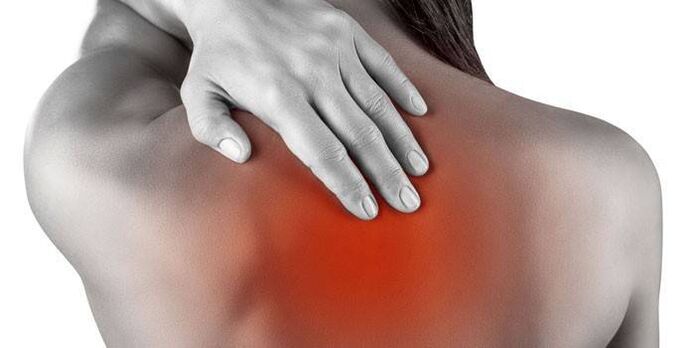The most common spinal column problem is osteochondrosis. The disease can attack every part of the spine, which experiences increased stress. It manifests itself at any age, more often the older generation belongs to the risk group. Symptoms of thoracic spine osteochondrosis increase with acute pain attacks.
What is osteochondrosis of the female thoracic spine
The disease is characterized by dystrophic and degenerative disorders of the spinal space, changes in the structure and shape of the intervertebral disc. Osteochondrosis of the spinal cord develops at age 40, and many patients carry it on their feet. This cannot be done, as over time the intercostal nerve is pinched; defects are not excluded. The upper thoracic vertebrae are involved in pathological processes, and patients guess about the disease with features of chest pain.
Symptoms of breast osteochondrosis in women
It is problematic to define a disease of the fairer sex, because its symptoms are similar to the manifestations of other pathological conditions of the female body. For example, an attack of acute pain in the peritoneal area can be the cause of damage to the mammary glands, or be the result of a heart attack, angina pectoris. To refute or confirm your guess, you need to take heart medication. The lack of positive dynamics indicates that the heart is healthy, and obvious problems occur in the spine.
Some patients believe that chronic gastritis or duodenal ulcers are the cause of the pain. In fact, these are characteristic signs of breast osteochondrosis in women, which only increases over time, becoming more intense, long-term. The diagnosis can be confused with herpes zoster, as the pain can be localized in the same area. To properly differentiate the disease, the characteristics of some symptoms are insufficient; an integrated approach to progressive problems is needed.

Symptoms of chest osteochondrosis in men
The disease can develop in the male body, especially if you follow an inactive lifestyle, choose hard physical work for yourself. Signs of thoracic osteochondrosis in men can be confused with acute pleurisy, angina pectoris, scoliosis, cholecystitis, and other myocardial pathologies. You can be sure that this is not a heart attack with medication, but only the treating doctor who prescribes the heart pill. Superficial self -medication cannot be ensured. With this disease, not only chest pain occurs, but also other symptoms:
- numbness in the legs;
- crawling on the skin;
- increased muscle tension;
- symptoms of potential decline;
- lumbago in the interscapular region.
How is chest osteochondrosis manifested?
The disease begins with an attack of acute pain, which is localized in the chest, resembling a heart attack. Initially, a painful sensation is observed when turning the body, tilting sharply and breathing deeply. Over time, dorsalgia reminds itself even at rest. Since the pathological focus is localized in the upper part of the chest, complications in the absence of adequate treatment are observed in relation to the myocardium, affecting the cardiovascular system. In addition, chest osteochondrosis is indicated by the following neurological symptoms:
- legs crawling;
- reflex tension of the back and chest muscles;
- pelvic organ dysfunction;
- numbness of the abdomen and upper sternum;
- pain that worsens with moderate exercise.
How does chest osteochondrosis hurt?
Not all patients know what a form of chest osteochondrosis is like - the symptoms do not remind themselves for some time. The localization of the lesion can be determined clinically, but the patient must first consult a specialist with complaints of back or lumbago pain between the shoulder blades. If they do not get timely treatment, the symptoms of a special disease will only increase, get worse. Chest pain with osteochondrosis has a different character, depending on the stage of the pathological process and the specifics of the organism.

Exacerbation of chest osteochondrosis
If the trunk remains in a sitting position for a long time, with progressive osteochondrosis, the occurrence of dorsago is not excluded. This is an attack of acute pain, which can radiate to the cervical and lumbar spine, while interfering with breathing, paralyzing the movement of the clinical patient. Exacerbation of thoracic osteochondrosis begins with sharp attacks on the left and right sides of the sternum, which are difficult to stop with medication. Such a situation cannot be simulated, as it confuses the patient to sleep, deprives him of sleep and rest.
If we talk about the symptoms of increasing dorsalgia, then this sign of thoracic osteochondrosis develops later. It appears in the hypochondrium, but before that develops invisible for 2-3 weeks. Extensive damage to the intercostal space begins with a general feeling of discomfort when changing the position of the trunk, which is then replaced by a dangerous attack of pain in the ridge area. Among such complications, doctors distinguish gallbladder inflammation and syphilis.
Attacks of osteochondrosis of the thoracic region
With an unpleasant disease, the nerve fibers are affected, so the attack is always accompanied by acute pain, which, in the early stages of development, has an unexplained localization. At first, unpleasant sensations are observed with sudden movements, if there is an increase in activity, with coughing and sneezing, but then certain symptoms remind themselves even at night, when the body is relaxing and resting.
Frequent attacks of pectalgia are not excluded, when acute pain is concentrated in the front of the chest, does not allow inhalation and respiration, literally paralyzes the whole body, disrupts the normal rhythm of life. If there is no timely therapy, painful osteochondrosis attacks in the thoracic area only increase, making once healthy people invalid.

Symptoms of advanced osteochondrosis
The disease at an advanced stage causes the displacement of the intervertebral disc, disrupting the shape and structure of the spinal space. For patients, this is an acute pain that does not allow turning the body, restricts movement and physical activity, which is one of the main causes of unstable emotional sphere. During the pathological process, systemic circulation is disrupted, and progressive symptoms of advanced osteochondrosis cause health complications such as:
- cardiac muscle dystrophy;
- renal dysfunction;
- intervertebral hernia;
- symptoms of potential decline;
- shingles;
- dystrophy of other parts of the spine;
- extensive internal organ lesions.

















































